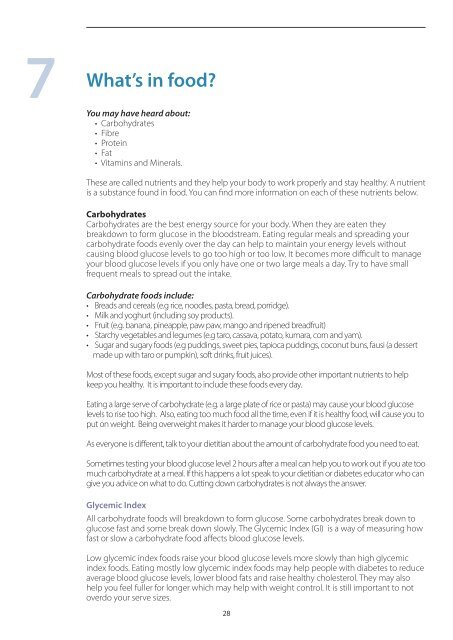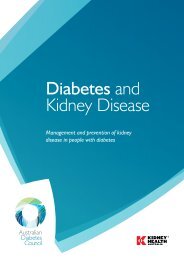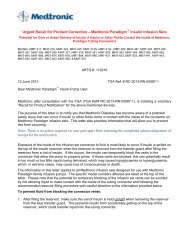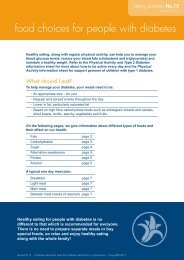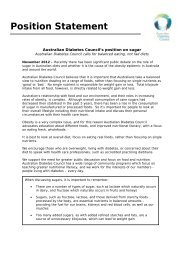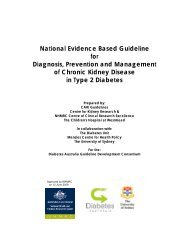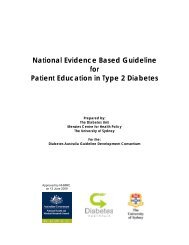O MeA e tAtAU OnA e IlOA - Australian Diabetes Council
O MeA e tAtAU OnA e IlOA - Australian Diabetes Council
O MeA e tAtAU OnA e IlOA - Australian Diabetes Council
You also want an ePaper? Increase the reach of your titles
YUMPU automatically turns print PDFs into web optimized ePapers that Google loves.
7<br />
What’s in food?<br />
You may have heard about:<br />
• Carbohydrates<br />
• Fibre<br />
• Protein<br />
• Fat<br />
• Vitamins and Minerals.<br />
These are called nutrients and they help your body to work properly and stay healthy. A nutrient<br />
is a substance found in food. You can find more information on each of these nutrients below.<br />
Carbohydrates<br />
Carbohydrates are the best energy source for your body. When they are eaten they<br />
breakdown to form glucose in the bloodstream. Eating regular meals and spreading your<br />
carbohydrate foods evenly over the day can help to maintain your energy levels without<br />
causing blood glucose levels to go too high or too low. It becomes more difficult to manage<br />
your blood glucose levels if you only have one or two large meals a day. Try to have small<br />
frequent meals to spread out the intake.<br />
Carbohydrate foods include:<br />
• Breads and cereals (e.g rice, noodles, pasta, bread, porridge).<br />
• Milk and yoghurt (including soy products).<br />
• Fruit (e.g. banana, pineapple, paw paw, mango and ripened breadfruit)<br />
• Starchy vegetables and legumes (e.g taro, cassava, potato, kumara, corn and yam).<br />
• Sugar and sugary foods (e.g puddings, sweet pies, tapioca puddings, coconut buns, fausi (a dessert<br />
made up with taro or pumpkin), soft drinks, fruit juices).<br />
Most of these foods, except sugar and sugary foods, also provide other important nutrients to help<br />
keep you healthy. It is important to include these foods every day.<br />
Eating a large serve of carbohydrate (e.g. a large plate of rice or pasta) may cause your blood glucose<br />
levels to rise too high. Also, eating too much food all the time, even if it is healthy food, will cause you to<br />
put on weight. Being overweight makes it harder to manage your blood glucose levels.<br />
As everyone is different, talk to your dietitian about the amount of carbohydrate food you need to eat.<br />
Sometimes testing your blood glucose level 2 hours after a meal can help you to work out if you ate too<br />
much carbohydrate at a meal. If this happens a lot speak to your dietitian or diabetes educator who can<br />
give you advice on what to do. Cutting down carbohydrates is not always the answer.<br />
Glycemic Index<br />
All carbohydrate foods will breakdown to form glucose. Some carbohydrates break down to<br />
glucose fast and some break down slowly. The Glycemic Index (GI) is a way of measuring how<br />
fast or slow a carbohydrate food affects blood glucose levels.<br />
Low glycemic index foods raise your blood glucose levels more slowly than high glycemic<br />
index foods. Eating mostly low glycemic index foods may help people with diabetes to reduce<br />
average blood glucose levels, lower blood fats and raise healthy cholesterol. They may also<br />
help you feel fuller for longer which may help with weight control. It is still important to not<br />
overdo your serve sizes.<br />
28


